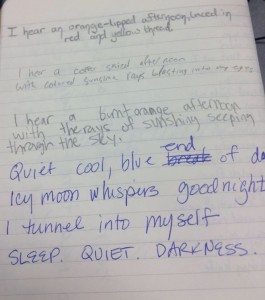Like me, many of my students were moved by Shawnee, Ohio. They described it as “moving,” “inspirational,”tear-inducing,” “physically painful,” “spectacular,” “genius,” “emotional,” “exhausting.” It was a sensory deluge many had never experienced before, and as we moved to Socratic discussion on Monday, it was challenging to tease out and discuss HOW they got to that place and WHY. We had experienced something profound, but teasing out sound and soundtrack, layers of voices, moving images and still images, past and present, tragedy and triumph eluded us. They could discuss the Q&A deftly, but the performance was jumbled, hard to unpack.
In my mind, this experience was a new model for our summative midterm: an amalgamation of oral history, personal experience, sensory writing, artifacts, images, sounds. We can use these techniques to create our own vignettes. My students were unconvinced that this was feasible. Too much work. How can we do all that? My goal in the next 6 weeks is to convince them they can.
As we moved through the week, an article in the New Yorker resonated with the performance we shared. I shared it with students and asked them to use the concrete details in one of the photos to write poetically or narratively about ONE image. Constraint is the key to productivity sometimes.
I have created a strong culture and community of readers this year (largely due to Kittle’s SSR model and choice reading), but students resist some of my attempts at being a community of writers. As I asked them to share their work, they resisited. Rather than delve into the details lovingly-wrought in their moleskin journals, they stared at images on their computer screens summarizing their thoughts, refusing to open up. Was their writing unshareable?
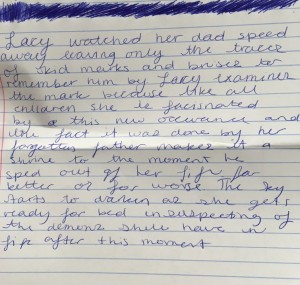
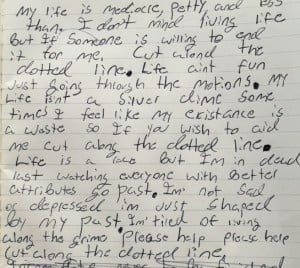
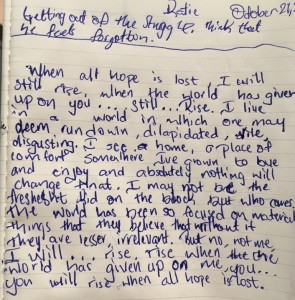
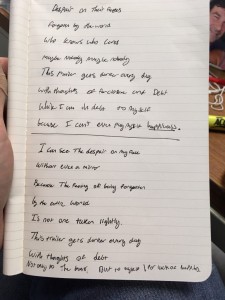
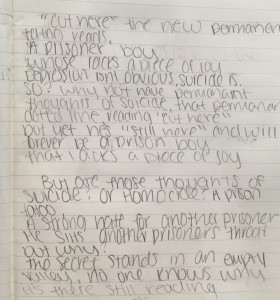
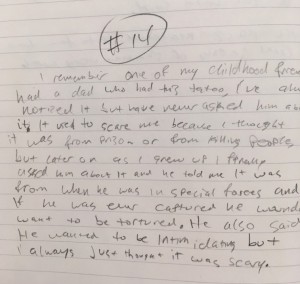
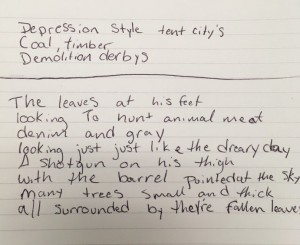 The writing was thoughtful, exquisite, true. But how can we make room for more than 5 voices in the classroom.
The writing was thoughtful, exquisite, true. But how can we make room for more than 5 voices in the classroom.
Amelia and Dionne visited the next day, aware of our strengths and struggles. It was a day to foreground process, to probe and question students, to question their assertions to help them show the ideas behind their reactions, to open up spaces to collaborate and write.
Students were supposed to bring in sounds from their homes and neighborhoods to swap and share. Some did. Some didn’t. Amelia improvised. Noah shared his sound from the back yard, and we shared his sound as a community of writers. (1) Amelia asked us to listen with our eyes closed, sussing out the layers of sound and the timeline of sounds. (2) We listened again. (3) In our journals we started with “I hear…” and listed as much we could. (4) We passed our moleskins to the left and with our peer’s observations, we rewrote the first lines with synonyms, adding our own voices, reetching the images gifted to us by our classmate. (5) We passed our moleskins to the left, and read the previous lines out peers had written. Again, we rewrote the sentence with synonyms. (6) We passed our moleskins to the left, but this time we shifted course. We wrote antonyms — a contrast — to the preceding lines. (7) Lastly, we shared, but time eclipsed our noblest goals. The bell rang. (8) Furiously, I scribbled my number on the board and exhorted the students to “text me a pic of your collaboration!” Here is a sampling. 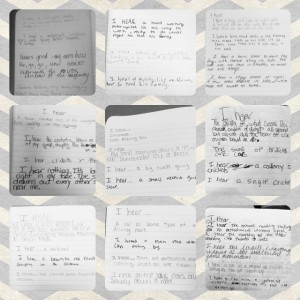
and one of my favorites:
Today we did it again (new sounds, new directions, similar passing and collaborating). We made sure to share. After we wrote, we circled up, we listened, we discussed. We keep building a community of writing, and we invite you to join us.
